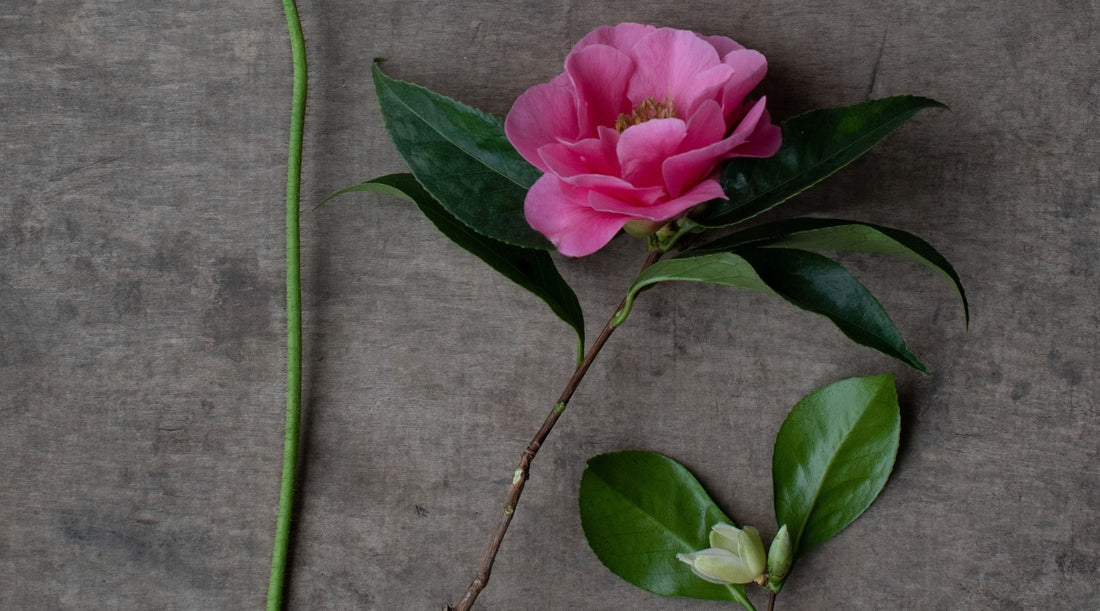With bright orange bells and lush foliage, Fritillaria imperialis (below, left), is an improbably tropical-looking thing to see flowering on a chilly April day in Derbyshire. But it does very well here. This particular species is one that people seem to either love or hate. Its peculiar, pungent smell perhaps doesn’t help, but to my mind, what it lacks in subtlety, it more than makes up for in character.

About six months before cutting this particular fritillary, I’d buried its huge, gorgeously gnarly bulb deep into the soil. They have a hole through their centre, so I dutifully planted it on its side, preventing the hole filling with water and causing rot.
I was late in planting the bulbs that year so they’d taken matters into their own hands, sending out thick, cream-coloured roots… a last-ditch attempt to find a food source for themselves. Their roots are brittle, so it's impossible not to snap some off when planting at this stage. When you’re a newbie gardener, this can send you into a frenzy of worry, but you soon realise just how resilient these plants are. Perfectly capable of regenerating the odd broken root. Still, I try to take care.

The months went by, and in late winter the lush glossy (slightly greasy-looking) leaves came nudging up out of the soil. They gained a good two or three feet in height before their flower-buds opened out into rich orange bells. The variety in this picture is ‘Rubra’, which has satisfyingly dark stems and similarly dark veining at the base of its flowers.
When it came time to cut the flower, I took a length of stem adequate for an arrangement. It’s vital to leave enough behind for photosynthesis to take place, so the bulb can grow a new flower next year. I hoped I hadn’t been too greedy. There’s a tension between wanting more now and wanting more later.
Half a year after committing that great bulb to the earth, whilst lamenting tardiness and broken roots, I had the joy of holding this flamboyant creation in my hand. I wondered what on earth I was going to do with it, would anything seasonal complement this weird, tropical thing in Derbyshire’s early spring?
Pink Camellias!

I tracked some down, then went searching in the glasshouse and found a particularly lovely Icelandic poppy, much more subtle in its colouring than the fritillary, but similarly extravagant with luxuriously ruffled petals. A good companion! They both had a feeling of liveliness about them.
I cut the poppy and, for a moment, remembered sowing the seed, fine-as-dust, on a warm late summer’s day, months earlier. Sometimes, I can’t help but wonder… how on earth this transformation is possible? Or perhaps, knowing a bit about the science, why is this even possible? I try to keep one foot rooted in reality and the other caught up in the wonder and awe of it all, especially when involved in the creative process or making anything new. It brought to mind the last lines of Mary Oliver’s poem The Swan:
“And did you feel it, in your heart, how it pertained to everything?
And have you too finally figured out what beauty is for?
And have you changed your life?”
Poppies can be a bit tricky to get started, especially Icelandic poppies. Their stems are tiny, thin and delicate, prone to rotting away in a cold wet winter, even in the warmth of a glasshouse. But with those huge, chiffon petals in mind, we persevere and learn to sow extra.
With the poppy and fritillary in hand, I was excited to have found two such characterful, eye-catching flowers to set alongside a few stems of joyous pink camellias.
I gathered some special tulips and set about arranging them to photograph, hopeful I’d do justice to the particular beauty and character of these flowers. I hope you enjoy the result.
Becky x

